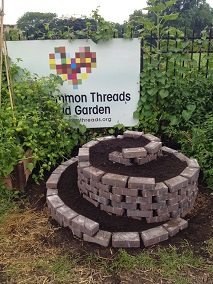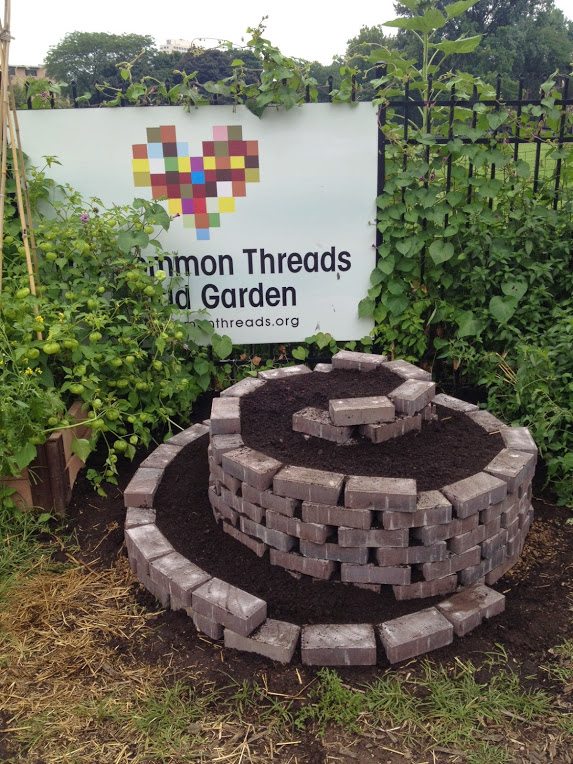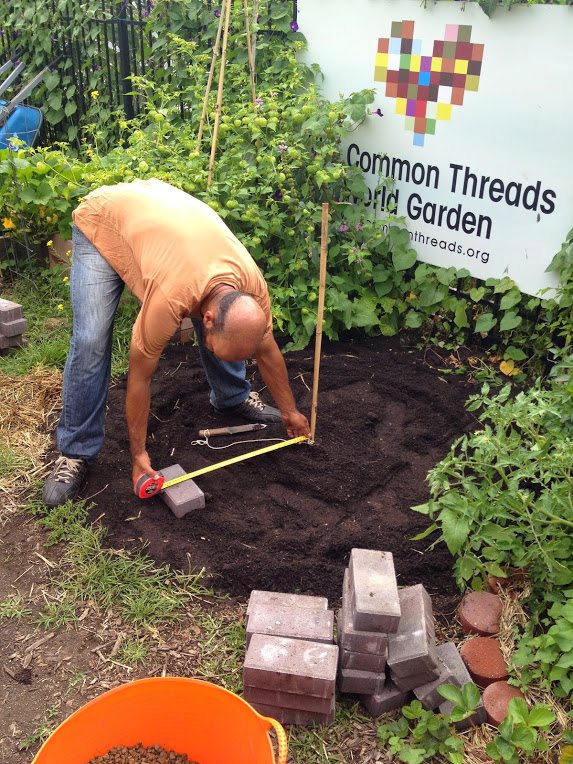Building an Herb Spiral

Making small healthy choices in your everyday life can turn into big changes. As members of the Healthy Weight Commitment Foundation, we promote the principles of energy balance and their Together Counts™ program by equipping children and parents with tools and to learn to cook meals at home. Cooking at home and preparing your own meals is one of the most significant changes you can make and is the only way to be certain that you are fueling yourself with healthy, whole food ingredients. Meals prepared at home don’t have to be overly complicated to be flavorful and tasty. Seasoning dishes with fresh herbs is the healthiest ways to make your food taste good. You can plant your own herb spiral garden with a little work and have fresh herbs at your fingertips.
The herb spiral garden is a modified raised bed and a feature of permaculture design. Permaculture is a branch of ecological design that is sustainable and modeled after the spiral design very commonly found in nature. Growing herbs in an herb spiral is beneficial for several reasons, including water distribution and efficient use of space. Here are some basic steps to build your own:
- Determine the radius by the users arm’s length so that there is enough space to walk around the completed herb spiral. To do this, place a pole in the center of where you will build your herb spiral. Stand where you can comfortably reach the pole. Mark this distance with rope and use that rope as the radius for the base of the herb spiral.
- Using the rope and gardening tool, trace a circle on the ground. This will approximate the first layer of bricks.
- Level the surface with pea gravel and cardboard, or anything else that will do the trick.
- Begin placing bricks on the outside of the traced circle. Bricks should lay end to end with their inner corners touching. This circle will be adjusted, but serves as a guide for laying out the rest of the herb spiral.
- After the guiding circle has been laid, trace a “flare” near the front of the spiral. This will be the first step in creating a spiral. Lay additional bricks along the traced “flare” line.
- Using the guiding circle and starting at the flare, begin moving each brick in one inch. When you have made it around the guiding circle begin laying the second circle of bricks 8 inches from the outer bricks. Do not stack bricks; this is creating a base for the herb spiral that will need to be leveled.
- Continue to lay base bricks, ensuring an 8-in gap between inner and outer bricks. Once you cannot add any more bricks in the center of the spiral take a look at the base layer and make necessary adjustments. If needed, bricks can be split in half with a hammer.
- Add a small layer of pea gravel under the bricks to help with draining. Check that the base layer of bricks is level, if not, use additional pea gravel to help level. Use a rubber mallet to help with leveling if necessary.
- The next steps move quickly – you’re almost done! Begin stacking bricks, starting with the flare of the spiral. From the flare, count 3.5 bricks and lay the second row (no mortar is needed). Count 3.5 bricks in on the second row and begin laying the third row. Repeat until you can no longer lay any more bricks. A hammer can be used to split bricks if necessary.
- Carefully begin filling the spiral with compost. The base of the taller areas of the herb spiral can be filled with stones or pea gravel as well. Be sure that these areas have at least 6-8 inches of compost at the top.
- Allow your herb spiral to sit for a few days to allow for settling. Top with additional compost if necessary. You’re ready to plant!
Herbs that require sun and good drainage would do well at the top of the spiral. Some choices include oregano, thyme, lavender, rosemary, dill and chamomile.
Herbs that require moister soil conditions and would do well in the middle of the spiral include basil, sage, tarragon, cilantro, Echinacea, yarrow and fennel.
Water loving herbs would be perfect for the bottom of the spiral. Mint, parsley, chives, calendula and feverfew would do well towards the bottom.
Materials:
- 160-250 bricks/stones, varies by size
- Level
- 2-3 Bags Pea Gravel (.5 cubic feet each)
- 1 5×5 ft. Piece of Cardboard
- 1 Measuring tape
- 1 Rubber mallet
- 1 Hammer
Below is a table to show the number of bricks Common Threads used in each row of our own herb spiral garden:
| Brick Row | Number of Bricks |
| 1 | 31 |
| 2 | 28 |
| 3 | 25 |
| 4 | 22 |
| 5 | 19 |
| 6 | 16 |
| 7 | 13 |
| 8 | 10 |
| 9 | 4 (Total = 168) |
This blog post was written by Linda Novick O’Keefe, the Co-Founding Chief Executive Officer of Common Threads. Her experience, desire to develop innovative solutions to social problems combined with her passion for food led her to start Common Threads with Chef Art Smith and artist Jesus Salgueiro in 2003. By sharing the delight of cooking and delicious recipes, in conjunction with practical life-skills in health and nutrition, Common Threads can change lives.


